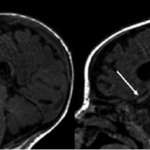Adrenoleukodystrophy is a type of genetic condition that damages the myelin sheath. Forms of X-linked adrenoleukodystrophy include:
- Childhood-onset adrenoleukodystrophy
- Addison’s disease
- Adrenomyeloneuropathy
What is the Pathology of Adrenoleukodystrophy?
Etiology: The cause of adrenoleukodystrophy genetic. It is an X-linked recessive condition caused by a mutation in the ABCD1 gene on the X chromosome. Because a female has two X chromosomes, if she inherits the faulty gene, then she still has another X chromosome to offset the mutation.
Genes involved: Mutations in the ABCD1 gene.
Pathogenesis: The sequence of events that lead to adrenoleukodystrophy is the mutations in the ABCD1 gene, which causes accumulation of very long-chain fatty acids in plasma and tissues.
How does Adrenoleukodystrophy Present?
Patients with Adrenoleukodystrophy are predominantly boys between ages 4 and 10. The symptoms, features, and clinical findings associated with Adrenoleukodystrophy include
Learning issues, vision issues, and coordinationissues. Virtually all males with adrenoleukodystrophy develop adrenal insufficiency and myelopathy.
How is Adrenoleukodystrophy Diagnosed?
Adrenoleukodystrophy is diagnosed by by physical exam and laboratory tests to check for high levels of very long-chain fatty acids in the blood.
How is Adrenoleukodystrophy Treated?
Adrenoleukodystrophy has no cure. Stem cell transplantation may be considered. Corticosteroids and physical therapy may be helpful.
What is the Prognosis of Adrenoleukodystrophy?
The prognosis of Adrenoleukodystrophy is generally poor due to progressive neurological deterioration unless bone marrow transplantation is done.



